- Ultra high efficiency DC Inverter+ Ducted Split Ceiling Concealed Heat Pump system. Horizontal Recessed Mounting
- Complete system set consisting of; Indoor Unit, Outdoor Unit and Installation Kit
- 18,000 BTU/h Cooling Capacity with 19.0 SEER High Efficiency Rating
- 18,000 BTU/h Heating Capacity with 10.5 HSPF High Efficiency Rating
- Voltage: 208~230 VAC, 60 Hertz, 1 Phase. For other specks see all pictures provided
Pioneer Air Conditioner RYB-22 Ceiling Concealed Slim Ductable Inverter++ Mini Split Heat Pump, 18000 BTU-208/230V
$1,658.00
Last updated on Details
Category: Split-System Air Conditioners
6 reviews for Pioneer Air Conditioner RYB-22 Ceiling Concealed Slim Ductable Inverter++ Mini Split Heat Pump, 18000 BTU-208/230V
Add a review Cancel reply
Related products
Split-System Air Conditioners
17.4 SEER2 MrCool Hyper Heat Central Ducted Split System with 10 Year Labor Warranty (3 Ton)
Rated 5.00 out of 5
$3,254,003,254.00
Split-System Air Conditioners
12k BTU 19 SEER MrCool Advantage Ductless Heat Pump Split System 3rd Generation – 115v
Rated 4.00 out of 5
$999.00
Split-System Air Conditioners
18k BTU 21.5 SEER MrCool Olympus Hyper Heat Ductless Heat Pump Split System – Wall Mounted
$1,724.51
Split-System Air Conditioners
Rated 4.25 out of 5
$4,414.00
Split-System Air Conditioners
KWIK-E-VAC Line Set Flushing Kit Installation Simplifier for Mini Split Air Conditioning Systems
Rated 4.00 out of 5
$45.99
Split-System Air Conditioners
$5,596.00
Split-System Air Conditioners
$1,655.10



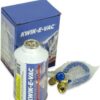
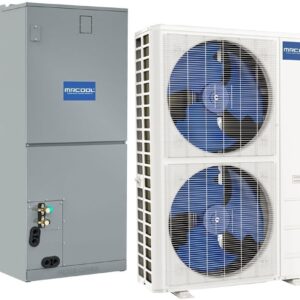
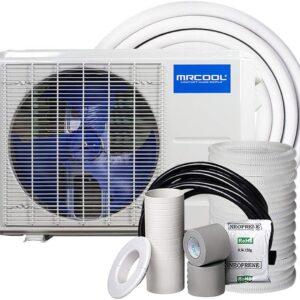
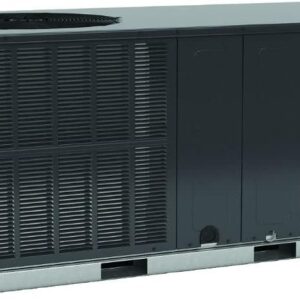
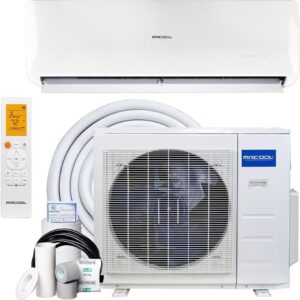
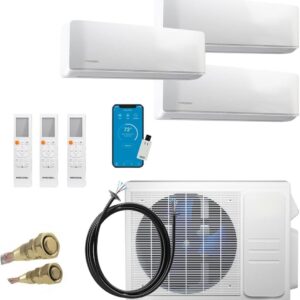
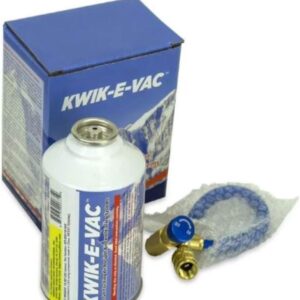
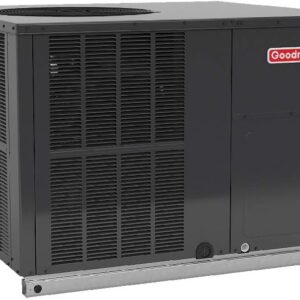
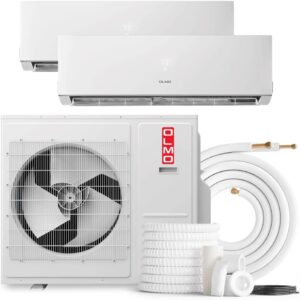
S D –
Room
A. Emerson –
I live in a small, 500 square foot house in the northeast USA. The previous owner was cooling it with a 10,000 BTU window air conditioner, a couple of pedestal fans to move the cool air, and a ceiling fan in every room. When that unit failed a few years after we moved in, we purchased two smaller units – one 5,000 BTU and the other 8,000 BTU. They were more than adequate for keeping things cool, but so loud that it was difficult to have a conversation or watch TV.
One of the few pitfalls of living in a smaller house is that wall space is at a premium. Ductless would have been half the price and only a quarter of the hassle, but there is seriously no wall space to hang a ductless unit anywhere that makes sense from a cooling perspective. Likewise, the previous owner sealed the attic access for reasons that I don’t want to know, so a ceiling mount was also not really an option. The only remaining choice is a ducted central AC system, with plenums and everything in the basement and vents poked up through the floor. Given that the smallest traditional system is 2.0 tons (24,000 BTU) and our space really needs only 12,000 BTU per the AC sizing guides, you can see how I wound up selecting this 18,000 BTU mini-split ducted unit.
For background purposes, I have to declare up front that I am over the hill and never once lived in a house/apartment with anything other than baseboard hot water heat. Since my current house had no ductwork, it meant that I had to design the entire layout from scratch with no previous experience to draw from. I searched online for web pages and videos of ductwork, and read debates on the evils of flex duct versus sheet metal ducts for several nights. My final design was a single 20×20” return grate at the center of the house, and one 6” round sheet metal duct to the far outside wall in each of the four nearly identically-sized rooms. Why the metal ducts? They flow air better than flex duct, and can be cleaned without worries of ripping the liner. Plus, the zinc coating in the galvanization allegedly has some anti-bacterial properties. Anyone copying my work can probably get away with a 16×20” return grate. I intentionally over-sized so that I had the option of running a super-fine allergy filter with extra surface area.
Hanging the outdoor unit on the foundation using the optional Pioneer brackets was simple, and I’ve done enough electrical work over the years where that wasn’t a challenge. Once the indoor unit was hanging, I routed the refrigerant lines and lubed up all of the flare surfaces with Nylog Blue. Highseer sells it in tiny little tubes, but does not include one in their Amazon package bundle. I ordered it directly from them, but you can pick it up in bigger bottles here. Their web site also has a single low-side pressure/vacuum gauge for a really good price, and I recommend it if you don’t already have an HVAC manifold and gauge set. I pulled a vacuum on the system for about an hour, closed the gauge valve, and let it sit for three weeks to prove to myself that it had no leaks and while I finished up the inside sheet metal work.
On a side note, I spent a few hours perusing the study guides for the EPA 608 test, and passed the exam at a local HVAC supply house. It is a gray area on whether or not you need to be certified in order to open the refrigerant valves on these units. I have a nosey neighbor who would absolutely call the EPA to get a cut of the $35,000 fine if he saw what I was doing, so the $50 test fee was cheap insurance (and opens up a new career line for me should I get tired of my current office job).
My distribution and return plenums were constructed from S-cleats and pre-formed materials from the big box store with orange signs. I was originally going to use old-school 2.5×12” baseboard register vents, but wound up making a last-minute change to 4×10” floor vents when I discovered that the baseboard register boxes would not clear the cinderblock foundation from the underside. I was concerned that the extra vent size would decrease the air velocity, but so far it is turning the air over quite nicely in all rooms.
Long story short, it took 2 months from order to powering up. I had to learn the duct design, electrical, refrigeration, and sheet metal trades, and buy the necessary tools, gauge, and a vacuum pump. If I had to do it all over again, I would probably pay a professional to do the install when considering that I spent almost an extra grand for tools and supplies on top of the unit’s price. If you are up for the challenge of learning several trades, I can certainly vouch that this system can be DIY installed.
As I write this, I’m *shivering* in a 70 degree house with the outdoor thermometer reading 93 degrees. I am still trying to figure out the best option for thermostat control. The supplied wired programmable thermostat looks nice, but seems to drift around +/- 5 degrees with the slightest breeze near it. In case you haven’t read it yet, there’s a “follow me” button on the thermostat (and IR remote) that tells the unit whether it should use the thermostat’s temperature sensor or one located inside the return of the air handler to control the temperature. Other reviewers prefer to use the thermostat’s sensor, but my experience after a few days is that the air handler’s return sensor is providing the most constant indoor temperature. Because the unit is reading the hot air coming back to be cooled again, I have the thermostat set for 74 degrees and it is holding 70 in all rooms. It is also worth mentioning that the 18,000 BTU unit apparently does not have the automatic airflow learning mode built in. With the ESP set at the default of zero and with the fan on auto, the air handler is slightly louder than a whisper but not quite as loud as the refrigerator. The outside unit is quiet enough where I needed to walk up to it to see if the fan was running at medium speed.
My oil-fired hot water heating system uses less than 300 gallons of heating oil per year. Although I have my doubts that the heat pump feature will result in significant savings, I plan to try it out in the fall to project the costs of not running the oil system.
In terms of cooling costs, the entire house is using 20.5 kWh per day, with the unit running 24/7 and outside temperatures in the 90’s.
Like I wrote as the title, I should have installed one of these units years ago…..
BISON RIDER –
Bought this for my 1200 sq ft house and ran ducts out of it to each room (and the garage). My buddy helped me install it and everything went in fine. I could have actually gotten a smaller unit but this thing is awesome for the price. I can’t believe how quiet the exterior fan unit is, I can barely hear it.
HeathFX –
Outdoor unit is so quiet, indoor unit is very quiet as well compared with a traditional split system. There are definitely some needless quirks with the ducted version that probably came from the wall-mounted world, but there is really no reason not to support traditional thermostats. Also, the wired controller should have bi-directional communication, so it doesn’t get out of sync with the remote. While I’ m talking about thermostats, the photo of the item does not match the wired controller that I was sent. It still works, but I despise this lack of attention to detail and why I knocked off a star from my rating. Another mini-split quirk is that the fan runs continuously at low speed even when there is no call for cold air. I feel like this wastes power and since I use the follow-me mode, using the temp sensor of the wired controller, theres no practical reason to circulate air. The unit is full-featured, even including a built-in condensate pump! I installed this in my mom’s “She Shed”, but I might buying another for my upcoming tiny-house. Might be a different brand though, because for all this unit’s features, it lacks any ability to use 3rd party thermostats.
DTBones –
I’ve had this installed for over 2 years, runs perfectly. Great customer support.
Amazon Customer –
When order this package, the line set was improperly sized. The manual clearly say 1/4 liquid and 1/2 gas. They sent the 1/2 and 3/4. Amazon was great refund so I can order the proper size.
The fan does not turn off when the set temperature reached. Only the condenser outside turn off and will take forever to turn back on when the room gets hot again. Not sure if other have the same issue or if the fan does not turn of but that every annoying and takes forever for the condenser to kicks on again. The room will be very hot by then. I call 2 differ contractors out and they just don’t know what to do.
The condensation drain is very odd sized that no standard pipe size in the US from lowes or Home Depot would fit.
The unit cannot read the remote. Not sure how it is set up because if you put the unit in the attic or crawl space, it will not be able to received the remote signal. The remote does not control the wall control. Takes forever for the unit to respond to the wall control.
Follow me function; not sure if it even function when that function is on. Definitely does not work with the remove because the unit cannot receive signal from the remote.
The one star is for the quietness of the unit. It is very quiet and smooth.
I emailed customer but never got an answer.
If it is not such a big item and easy to take apart, I would definitely return it. That’s the reason I went with amazon rather then straight from the company.